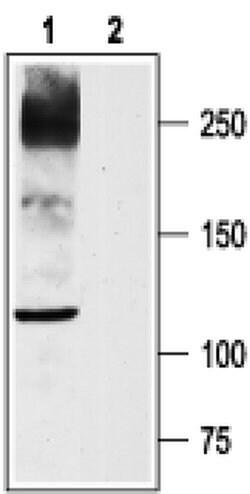Promotional price valid on web orders only. Your contract pricing may differ. Interested in signing up for a dedicated account number?
Learn More
Learn More
SCN10A Polyclonal Antibody, Invitrogen™
Rabbit Polyclonal Antibody
Supplier: Thermo Scientific PA577732
Description
Product is shipped at room temperature as a lyophilized powder and should be stored at -20 °C upon receipt. Reconstitution: add 50 μL of deionized water.
Scn10a is a tetrodotoxin-resistant voltage-gated sodium channel alpha subunit. Epithelial sodium channels are amiloride-sensitive members of the Degenerin/epithelial sodium channel (Deg/ENaC) superfamily of ion channels. Scn10a mediates the voltage-dependent sodium ion permeability of excitable membranes. Assuming opened or closed conformations in response to the voltage difference across the membrane, Scn10a forms a sodium-selective channel through which sodium ions may pass in accordance with their electrochemical gradient. Scn10a also plays a role in neuropathic pain mechanisms. Structurally, members of Deg/ENaC superfamily of ion channels share organizational similarity in that they all possess two short intracellular amino and carboxyl termini, two short membrane spanning segments, and a large extracellular loop with a conserved cysteine-rich region. There are three homologous isoforms of the ENaC (alpha, beta, and gamma) protein. ENaC in the kidney, lung, and colon plays an essential role in trans-epithelial sodium and fluid balance. ENaC also mediates aldosterone-dependent sodium reabsorption in the distal nephron of the kidney, thus regulating blood pressure. ENaC is thought to be regulated, in part, through association with the cystic fibrosis transmembrane conductance regulator (CFTR) chloride ion channel. Gain-of-function mutations in beta- or gamma-ENaC can cause severe arterial hypertension (Liddels syndrome) and loss-of-function mutations in alpha- or beta-ENaC causes pseudohypoaldosteronism (PHA-1). Diseases associated with SCN10A include Episodic Pain Syndrome, Familial, 2 and Sodium Channelopathy-Related Small Fiber Neuropathy.
Specifications
| SCN10A | |
| Polyclonal | |
| Unconjugated | |
| SCN10A | |
| PN3 | |
| Rabbit | |
| Antigen affinity chromatography | |
| RUO | |
| 29571, 6336 | |
| -20°C | |
| Lyophilized |
| Immunocytochemistry, Immunofluorescence, Immunohistochemistry (Paraffin), Immunoprecipitation, Western Blot | |
| 0.8 mg/mL | |
| PBS with 1% BSA and 0.05% sodium azide; pH 7.4 | |
| Q62968, Q9Y5Y9 | |
| Scn10a | |
| Peptide (C)EDEVAAKEGNSPGPQ, corresponding to amino acid residues 1943-1956 of rat Nav 1.8 | |
| 50 μL | |
| Primary | |
| Human, Rat | |
| Antibody | |
| IgG |
Product Content Correction
Your input is important to us. Please complete this form to provide feedback related to the content on this product.
Product Title
Spot an opportunity for improvement?Share a Content Correction


